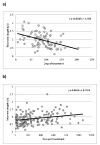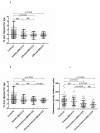Impact of chemotherapy on telomere length in sporadic and familial breast cancer patients
- PMID: 25528024
- PMCID: PMC4824277
- DOI: 10.1007/s10549-014-3246-6
Impact of chemotherapy on telomere length in sporadic and familial breast cancer patients
Abstract
Recently, we observed that telomeres of BRCA1/2 mutation carriers were shorter than those of controls or sporadic breast cancer patients, suggesting that mutations in these genes might be responsible for this event. Given the contradictory results reported in the literature, we tested whether other parameters, such as chemotherapy, could be modifying telomere length (TL). We performed a cross-sectional study measuring leukocyte TL of 266 sporadic breasts cancer patients treated with first-line chemotherapy, with a median follow-up of 240 days. Additionally, we performed both cross-sectional and longitudinal studies in a series of 236 familial breast cancer patients that included affected and non-affected BRCA1/2 mutation carriers. We have measured in leukocytes from peripheral blood: the TL, percentage of short telomeres (<3 kb), telomerase activity levels and the annual telomere shortening speed. In sporadic cases we found that chemotherapy exerts a transient telomere shortening effect (around 2 years) that varies depending on the drug combination. In familial cases, only patients receiving treatment were associated with telomere shortening but they recovered normal TL after a period of 2 years. Chemotherapy affects TL and should be considered in the studies that correlate TL with disease susceptibility.
Figures





References
-
- Blackburn EH. Switching and signaling at the telomere. Cell. 2001 Sep 21;106(6):661–673. - PubMed
-
- Blasco MA. Telomeres and human disease: ageing, cancer and beyond. Nat Rev Genet. 2005 Aug;6(8):611–622. - PubMed
-
- Muezzinler A, Zaineddin AK, Brenner H. A systematic review of leukocyte telomere length and age in adults. Ageing Res Rev. Mar;12(2):509–519. - PubMed
-
- Harley CB, Futcher AB, Greider CW. Telomeres shorten during ageing of human fibroblasts. Nature. 1990 May 31;345(6274):458–460. - PubMed
-
- Kong CM, Lee XW, Wang X. Telomere shortening in human diseases. FEBS J. Jul;280(14):3180–3193. - PubMed
Publication types
MeSH terms
Supplementary concepts
Grants and funding
LinkOut - more resources
Full Text Sources
Other Literature Sources
Medical
Miscellaneous

